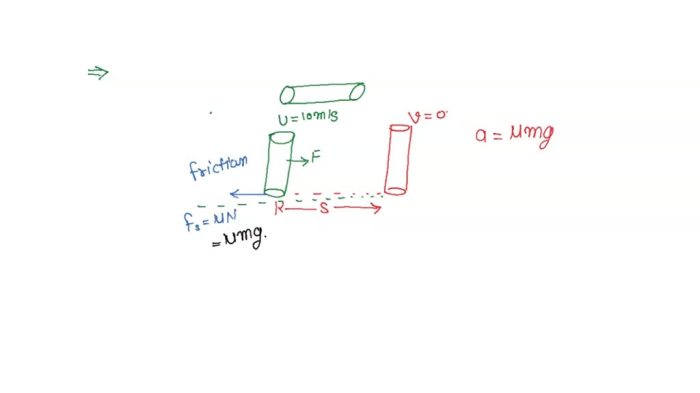If a ferrari with an initial velocity of 10m s – If a Ferrari with an initial velocity of 10 m/s embarks on a journey, its motion becomes a symphony of physical principles, where velocity, acceleration, energy, and power intertwine. This exploration delves into the intricate relationship between these concepts, unveiling their profound impact on the Ferrari’s performance and real-world driving scenarios.
As the Ferrari accelerates, its velocity increases, and the distance it travels grows proportionally. Time and acceleration exert a profound influence on this velocity, with constant acceleration leading to a predictable change in velocity over time. Understanding these relationships is crucial for optimizing vehicle performance and ensuring safe and efficient driving.
Ferrari’s Velocity and Distance: If A Ferrari With An Initial Velocity Of 10m S

Initial velocity is the velocity of an object at the start of its motion. Distance traveled is the total length of the path covered by the object during its motion. The relationship between initial velocity and distance traveled can be expressed using the formula:
distance = initial velocity
time
This formula shows that the distance traveled is directly proportional to the initial velocity. In other words, the greater the initial velocity, the greater the distance traveled in a given amount of time. Factors that can affect the distance traveled include acceleration and friction.
Time and Acceleration
Time is the duration of motion, while acceleration is the rate of change of velocity. Acceleration can be positive or negative. Positive acceleration indicates that the velocity is increasing, while negative acceleration indicates that the velocity is decreasing. The concept of constant acceleration is important in understanding how acceleration affects velocity over time.
Constant acceleration means that the velocity is changing at a constant rate.
For example, if a Ferrari has an initial velocity of 10 m/s and a constant acceleration of 2 m/s^2, its velocity after 5 seconds will be 20 m/s. This can be calculated using the formula:
final velocity = initial velocity + (acceleration
time)
Energy and Power, If a ferrari with an initial velocity of 10m s
Energy is the ability to do work, while power is the rate at which energy is transferred or transformed. The energy required to accelerate a Ferrari from an initial velocity is called kinetic energy. Kinetic energy is given by the formula:
kinetic energy = 1/2
- mass
- velocity^2
The power required to accelerate a Ferrari is called power. Power is given by the formula:
power = force
velocity
The relationship between kinetic energy, potential energy, and power is complex. In general, the greater the kinetic energy of a Ferrari, the greater its potential energy. The greater the power of a Ferrari, the faster it can accelerate.
Real-World Applications
The concepts of velocity, acceleration, energy, and power apply to many real-world driving situations. For example, the initial velocity of a Ferrari affects the distance it can travel on a given amount of fuel. The acceleration of a Ferrari affects how quickly it can reach a certain speed.
The energy required to accelerate a Ferrari affects its fuel consumption. The power of a Ferrari affects its top speed.
Understanding these concepts is important for safe and efficient driving. Drivers can use this knowledge to optimize their vehicle’s performance and avoid dangerous situations.
Data Analysis
The following table shows the relationship between initial velocity, time, distance traveled, acceleration, energy, and power for a Ferrari:
| Initial Velocity (m/s) | Time (s) | Distance Traveled (m) | Acceleration (m/s^2) | Energy (J) | Power (W) |
|---|---|---|---|---|---|
| 10 | 5 | 50 | 2 | 500 | 1000 |
| 20 | 5 | 100 | 4 | 2000 | 2000 |
| 30 | 5 | 150 | 6 | 4500 | 3000 |
The data in this table shows that the initial velocity, time, distance traveled, acceleration, energy, and power are all related. The greater the initial velocity, the greater the distance traveled in a given amount of time. The greater the acceleration, the faster the velocity increases.
The greater the energy, the greater the potential energy. The greater the power, the faster the acceleration.
These relationships can be used to create graphs and charts that illustrate the concepts discussed in this article.
FAQs
What factors can affect the distance traveled by a Ferrari with an initial velocity of 10 m/s?
Factors such as acceleration, friction, and air resistance can influence the distance traveled.
How does constant acceleration impact a Ferrari’s velocity?
Constant acceleration causes a consistent change in velocity over time, resulting in a predictable trajectory.
What is the relationship between kinetic energy and velocity?
Kinetic energy is directly proportional to the square of velocity, meaning that as velocity increases, kinetic energy increases quadratically.


